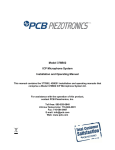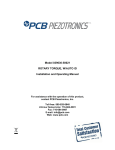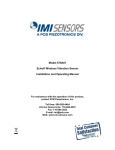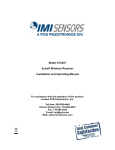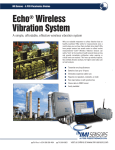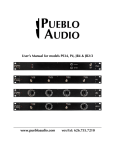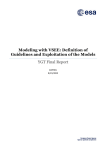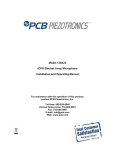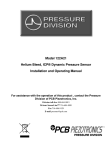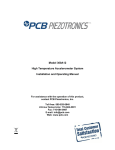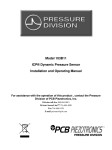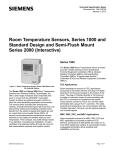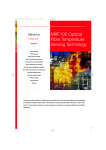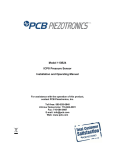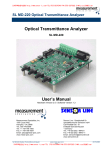Download Model 109C12 ICP® Pressure Sensor Installation and Operating
Transcript
Model 109C12 ICP® Pressure Sensor Installation and Operating Manual For assistance with the operation of this product, contact PCB Piezotronics, Inc. Toll-free: 800-828-8840 24-hour SensorLine: 716-684-0001 Fax: 716-684-0987 E-mail: [email protected] Web: www.pcb.com Warranty, Service, Repair, and Return Policies and Instructions The information contained in this document supersedes all similar information that may be found elsewhere in this manual. Total Customer Satisfaction – PCB Piezotronics guarantees Total Customer Satisfaction. If, at any time, for any reason, you are not completely satisfied with any PCB product, PCB will repair, replace, or exchange it at no charge. You may also choose to have your purchase price refunded in lieu of the repair, replacement, or exchange of the product. Service – Due to the sophisticated nature of the sensors and associated instrumentation provided by PCB Piezotronics, user servicing or repair is not recommended and, if attempted, may void the factory warranty. Routine maintenance, such as the cleaning of electrical connectors, housings, and mounting surfaces with solutions and techniques that will not harm the physical material of construction, is acceptable. Caution should be observed to insure that liquids are not permitted to migrate into devices that are not hermetically sealed. Such devices should only be wiped with a dampened cloth and never submerged or have liquids poured upon them. Repair – In the event that equipment becomes damaged or ceases to operate, arrangements should be made to return the equipment to PCB Piezotronics for repair. User servicing or repair is not recommended and, if attempted, may void the factory warranty. Calibration – Routine calibration of sensors and associated instrumentation is recommended as this helps build confidence in measurement accuracy and acquired data. Equipment calibration cycles are typically established by the users own quality regimen. When in doubt about a calibration cycle, a good “rule of thumb” is to recalibrate on an annual basis. It is also good practice to recalibrate after exposure to any severe temperature extreme, shock, load, or other environmental influence, or prior to any critical test. PCB Piezotronics maintains an ISO9001 certified metrology laboratory and offers calibration services, which are accredited by A2LA to ISO/IEC 17025, with full traceablility to N.I.S.T. In addition to the normally supplied calibration, special testing is also available, such as: sensitivity at elevated or cryogenic temperatures, phase response, extended high or low frequency response, extended range, leak testing, hydrostatic pressure testing, and others. For information on standard recalibration services or special testing, contact your local PCB Piezotronics distributor, sales representative, or factory customer service representative. Returning Equipment – Following these procedures will insure that your returned materials are handled in the most expedient manner. Before returning any equipment to PCB Piezotronics, contact your local distributor, sales representative, or factory customer service representative to obtain a Return Materials Authorization (RMA) Number. This RMA number should be clearly marked on the outside of all package(s) and on the packing list(s) accompanying the shipment. A detailed account of the nature of the problem(s) being experienced with the equipment should also be included inside the package(s) containing any returned materials. PCB for a complete statement of our warranty. Expendable items, such as batteries and mounting hardware, are not covered by warranty. Mechanical damage to equipment due to improper use is not covered by warranty. Electronic circuitry failure caused by the introduction of unregulated or improper excitation power or electrostatic discharge is not covered by warranty. A Purchase Order, included with the returned materials, will expedite the turn-around of serviced equipment. It is recommended to include authorization on the Purchase Order for PCB to proceed with any repairs, as long as they do not exceed 50% of the replacement cost of the returned item(s). PCB will provide a price quotation or replacement recommendation for any item whose repair costs would exceed 50% of replacement cost, or any item that is not economically feasible to repair. For routine calibration services, the Purchase Order should include authorization to proceed and return at current pricing, which can be obtained from a factory customer service representative. Contact Information – International customers should direct all inquiries to their local distributor or sales office. A complete list of distributors and offices can be found at www.pcb.com. Customers within the United States may contact their local sales representative or a factory customer service representative. A complete list of sales representatives can be found at www.pcb.com. Toll-free telephone numbers for a factory customer service representative, in the division responsible for this product, can be found on the title page at the front of this manual. Our ship to address and general contact numbers are: Warranty – All equipment and repair services provided by PCB Piezotronics, Inc. are covered by a limited warranty against defective material and workmanship for a period of one year from date of original purchase. Contact DOCUMENT NUMBER: 21354 DOCUMENT REVISION: B ECN: 17900 PCB Piezotronics, Inc. 3425 Walden Ave. Depew, NY 14043 USA Toll-free: (800) 828-8840 24-hour SensorLineSM: (716) 684-0001 Website: www.pcb.com E-mail: [email protected] OPERATION MANUAL FOR ICP HIGH PRESSURE SENSORS Models 109A, A02, A11, A12 Models 109B11, B12 1.0 INTRODUCTION The Model 109A is an acceleration-compensated high pressure sensor designed to measure very fast transient pressure pulses as produced by detonations, gas guns, projectiles and closed bomb tests. These types of tests are usually accompanied by very large acceleration pulses which can add considerable error to output signals of noncompensated sensors. The Model 109A features a very high natural frequency, minimizing ringing effects usually triggered by very short rise time input pulses. The Model 109A02 is similar in all respects to the Model 109A except for range. The 109A has a range of 80,000 psi, while the 109A02 is rated at 100,000 psi full scale. The 109A series is not intended for continuous duty such as in fuel injector pumps. This amplifier (actually an impedance converter with unity gain) converts the high-impedance level voltage from the quartz package into a low-impedance (100 ohms), high-level (6 V-109A, 7 V -109A02) output signal. The amplifier utilizes two wires, i.e. signal and power are conducted through a single coaxial connector. The signal is separated from the bias level (about +11 V) in the power unit by use of a decoupling capacitor when using power units Series 480B, 482A, 483A, 485B and others. The signal is separated from the bias level by DC voltage level-shifting methods in power unit Model 484B. This unit is useful for calibration. See Guide G-0001B, "General Guide to ICP Instrumentation", for more complete coverage of ICP (Integrated Circuit Piezoelectric) instruments. 3.0 2.0 1 INSTALLATION DESCRIPTION The Model 109A (see figure below) contains a very rigid acceleration-compensated quartz element coupled to a tiny microelectronic amplifier located near the electrical connector. 10-32 Co-Axial Connector ICP Amplifier 5/16 Hex 3/8-24 Thd. Acceleration Compensated Element Ceramic Coating Series 109A Sensor Drawing Number: 21113 Revision: NR The series 109A Sensors mount directly in existing ports machined for PCB Models 118A, 108A and 119A. Unlike conventional diaphragm type sensors, the 109A is pressure sensitive over the entire frontal area. For this reason, extra care should be exercised to avoid bottoming in mounting hole when recessed mounted and especially when mounting into existing mounting ports. A torque wrench should be used to monitor the mounting torque value when installing the series 109A. The recommended range is given on the installation drawing. 3.1 MOUNTING IN RECESSED PORTS EXISTING Before installing the sensor in previously used mounting ports, clean out residue from previous tests as shown in figure below. This can be accomplished by hand reaming the 1/4" diameter hole using a PCB Model 040A end cutting reamer (or equivalent). OPERATION MANUAL FOR ICP HIGH PRESSURE SENSORS Models 109A, A02, A11, A12 Models 109B11, B12 Model 040A Reamer 2 This type of mounting protects the sensor diaphragm from the effects of high-flash temperatures and particle impingement due to blast effects, thereby prolonging sensor life. The recommended range of passage diameters is .090 to .125 diameter. The limitation in this type of installation lies in the frequency-limiting effects of the passage due to its length. Residue Existing Recessed Ports During prolonged testing, should waveform distortion occur, remove sensor and remove residue as shown. The passage behaves like an underdamped second order system, the resonant frequency being determined by the passage length. This can have a limiting effect of pressure pulse rise time while causing passage ringing in cases where the passage is too long. Recessed Mount It is important to note that, should the seal surface require remachining to clean up after prolonged use, don't forge to deepen the 1/4" diameter hole by the same amount. Otherwise, the sensor may bottom when installed. 3.2 PREPARING NEW MOUNTING PORTS Refer to installation drawing provided in this manual for instructions in mounting hole preparation. For best results, do not deviate from the steps outlined in this drawing. Use good machining practice in preparation of the mounting port, paying particular attention to the seal surface (.323 diameter), and keeping it free from tool chatter marks. NOTE: It is important that this surface be perfectly smooth and free from nicks or other discontinuities which might cause leaks at high pressures. 3.3 RECESSED MOUNT The recessed installation is shown in figure below. Drawing Number: 21113 Revision: NR .010 min. The following relationship determines this resonant frequency (f r): fr V 4L (Hz) (EQ. 1) Where: f r = Resonant frequency of passage (Hz) V = Velocity of sound in air (ft/sec) L = Length of column (ft) OPERATION MANUAL FOR ICP HIGH PRESSURE SENSORS Models 109A, A02, A11, A12 Models 109B11, B12 3.5 For air at room temperature, (EQ. 1) becomes: fr 3000 L The natural frequency and approximate fastest pressure step rise time for various length passages is shown in the following chart. (Medium, air at 25 C). .050 .100 .200 .50 1.0 PASSAGE RESONANCE (kHz) 66 33 16.5 6.6 3.3 APPROX. FASTEST PULSE RISE TIME (Sec) 5 10 20 50 100 Passage Resonance vs. Passage Length Actual resonant frequencies measured in practice may differ slightly from the chart values due to variations in the velocity of propagation of sound in air caused by changes in temperature and pressure of the air in the passage. However, if more protection from flash thermal effects is required with the recessed mount, the passage can be filled with silicone grease (DC-4 or equivalent). Several layers of black vinyl electrical tape directly on the diaphragm has proven effective in many cases. Flash temperature effects are usually longer term and will show up as baseline shift long after the event to be measured has passed. For flush mount installations, a silicone rubber coating approximately .010” thick can be effective. GE RTV type 106 is recommended. Follow manufacturer’s instructions to apply. It is best to recess the diaphragm .010” for this type of protection. 3.6 INSTALLING CABLES 480B 002A DC DVM For best matching of passage to diaphragm, maintain the .010” clearance ahead of the diaphragm as shown in Recessed Mount figure. 3.4 TEMPERATURE The ceramic coating on the diaphragm of these sensors should render the flash thermal effect insignificant in most cases, especially when recessed mounted. (EQ. 2) Where: L = Passage length (in.) PASSAGE LENGTH (in) FLASH EFFECTS 3 FLUSH MOUNT In the flush mount installation, there is no reduced area passage from the sensor diaphragm to the test chamber, rather the sensor diaphragm is mounted flush with (or slightly recessed from) the inside surface of the test chamber. Use this type of installation only if space or rise time considerations preclude the use of the recessed installation. In severe pyrotechnic environments, sensor life may be severely limited with flush installation. Drawing Number: 21113 Revision: NR 109A Model 070A01 "T" Adaptor It is convenient, though not necessary, to use coaxial cable such as PCB Model 002A to connect sensor to power unit. Cable need not be low-noise treated, and in fact, if it is desired to use lighter, more flexible cable, 070A09 solder connector adaptors may be used to employ twisted pair or other types of two-wire cable. OPERATION MANUAL FOR ICP HIGH PRESSURE SENSORS Models 109A, A02, A11, A12 Models 109B11, B12 3.7 CIRCUIT CONNECTIONS Model 484B 4 DC DVM The two following figures show two typical circuit connections normally used with the 109A series to connect to the power units. The first figure is the most often used connection scheme for most applications. In this set up, the signal is AC-coupled from the bias voltage by a 10 µF capacitor located in the power unit. The voltage at the "scope" terminal will be at a "O" volt bias level. Model 002A DC 109A Model 480B Oscilloscope Typical Connection Model 012A The figure above shows the 109A connected to the Model 484B Power Unit. The 484B is a dual-mode power unit, i.e., the output signal can be AC- or DCcoupled from the sensor. XDCR 109A SCOPE Readout In the DC mode, a level-shifting circuit removes the bias level and provides a zero adjust feature at the front panel. Normal Connection AC-Coupled Output In the DC mode, the system discharge time constant is determined by the sensor. In this case, the system discharge time constant will be determined by the value of the input resistance (R) of the readout device and the 10 µF capacitor (C) in accordance with the following relationship: An AC-coupled mode is provided for normal ACcoupled operation. TC (seconds) = R (ohms) C (farads) 4.0 Alternate Connection to take Advantage of Sensor Discharge TC Static calibration methods may be employed using the set-up shown in the alternate connection figure or by use of the Model 484B Power Unit as shown in above figure. Use 484B in DC mode. The second figure illustrates an optional connection scheme which can be used during calibration to take full advantage of the sensor discharge time constant. CALIBRATION With this arrangement, the readout is direct-coupled to the sensor and the output signal will be added to the +11 volt (Nom) bias level. Use high pressure pump with dial reference sensor or a dead weight tester to apply pressure in desired increments to full scale. Dump pressure after taking the reading and before proceeding to the next higher pressure level. The discharge time constant will now be determined only by the sensor and should be in the order of 2000 seconds. This is sufficient for most types of static calibration methods. (See calibration section 4.0.) With a 2000 second discharge TC, 1% of the signal will be lost in 20 seconds, so it is imperative that the pressure setting and recording of output be accomplished quickly. A calibration graph can then be plotted using output voltage vs. input pressure. Drawing Number: 21113 Revision: NR OPERATION MANUAL FOR ICP HIGH PRESSURE SENSORS Models 109A, A02, A11, A12 Models 109B11, B12 5.0 OPERATION Select desired mode of circuit connection and turn power unit on. Observe fault monitor meter at the front panel of the power unit. Normal operation is indicated by an approximate midscale reading. Shorted cable or connections are indicated by a zero reading (red area). Open cable or connections are indicated by a fullscale (yellow area) reading. Allow instrument several minutes to warm up and thermally stabilize. When output from power unit is connected to readout equipment, a drifting of the voltage signal will be noticed. This is normal. It is due to the charging of the coupling capacitor in the power unit and will cease within several minutes. 6.0 POLARITY The series 109A produces a positive-going output voltage for increasing pressure at the diaphragm. 7.0 MAINTENANCE The small size and sealed construction of the series 109A precludes field maintenance and repair. Drawing Number: 21113 Revision: NR ICP is a registered trademark of PCB Piezotronics 5











